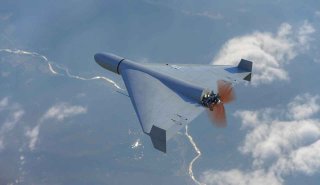Russia Launched 8,060 Iranian Shahed-136 Drones Against Ukraine in 2024
The Shahed-136 is particularly vexing for nations on the receiving end of its attacks. The drone poses significant defensive challenges, as both the Houthis out of Yemen and the Russians fighting in Ukraine have shown.
In September of last year, it was reported that Russia had launched an astonishing 8,060 drones developed by the long-time Russian ally, the Islamic Republic of Iran, in Russia’s ongoing war against Ukraine.
At the time, it was an extraordinary number. The reporting back in September 2024 highlighted the importance that unmanned aerial vehicles (UAVs) of all shapes and sizes had for both sides fighting in Ukraine (the Ukrainians use overwhelming numbers of Turkish-produced drones).
The Iranian drones that Russia loves are the Shahed-131 and Shahed-136 one-way attack unmanned aerial systems. In an October 2022 assessment by the Council of Foreign Relations, the bulk of the drones Iran handed over to Russia belonged to the Shahed-136 model. That’s the specific Iranian-built drone we’ll be analyzing here.
Back in March, the Russians signed a licensing agreement with Iran that allowed them to domestically produce these systems. According to a November 2024 report by Iran International, a website that advocates the end of the Islamist regime in Iran, the presence of large numbers of cheaply produced Iranian drones “supercharged Russia’s 1,000-day fight in Ukraine.”
An Iranian Nightmare in Ukraine
With Russia now mass producing the Iranian drones indigenously, the Russians will likely continue enjoying the boost that the drones gave their forces when the Iranians first sold the drones to Russia. As the fight over control of the Russian enclave of Kursk, located just across the border from Ukraine has shown, Russian drones are wreaking havoc on the entrenched Ukrainian forces operating there.
The Shahed-136, also known as “Witness” (or, Geran-2, meaning “Geranium-2” in Russian), is a delta-winged loitering munition designed for long-range attacks. The brilliance of the system lies in its relative simplicity that allows for cheap mass production and lower maintenance costs compared to other, more sophisticated drones. It has a range of a little more than 1,200 miles and can carry a warhead weighing between 88 and 110 pounds. Shahed-136 drones typically have a subsonic cruising speed of 111 miles per hour.
The basic tactics underlying the deployment of these systems involve the saturation of enemy defenses with swarms of cheaply produced Shahed-136 drones, thereby overwhelming an enemy’s air defenses and allowing for the attacking force to achieve dominance over a contested area. Another tactic involves stealthy, surgical strikes, since these drones’ relatively small size and low-flying capability makes it more difficult for defenders to see and defend against them.
Iranian Shahed-136 drones have also been used by the Iranian-backed Houthis in their efforts to terrorize international shipping—and the mighty United States Navy—in the Red Sea and Strait of Bab El-Mandeb. That Tehran is the producer of this specific drone should not surprise anyone. Being a relatively small power under immense international sanctions has meant that the Iranian regime has had to innovate unique asymmetrical warfare capabilities.
No Easy Defense
The Shahed-136 is particularly vexing for nations on the receiving end of its attacks. The drone poses significant defensive challenges, as both the Houthis out of Yemen and the Russians fighting in Ukraine have shown. Drones have proven that only layered air defense systems have a chance at reliably countering the threat that drone swarms pose to defenders.
Such systems, however, are expensive to maintain—especially when compared to the relative cost and the overwhelming lethality of the Shahed-136 drones. What’s more, the risk of Iran proliferating these systems to other actors, particularly non-state actors, such as terrorist organizations beyond the Houthis, is a real complicating factor when it comes to defense.
Iranian weapons designers have already learned a great deal from the experience of their systems in various theaters of global warfare. They are applying those lessons learned to future iterations both of the Shahed-136 and other, more advanced Iranian drones.
It is obvious that drone warfare will continue to evolve and to increasingly dominate the future of modern warfare. The Iranians understand this. As do the Turks and Russians. We shall see if the Western world truly understands this new reality.
Brandon J. Weichert, a Senior National Security Editor at The National Interest as well as a Senior Fellow at the Center for the National Interest, and a contributor at Popular Mechanics, consults regularly with various government institutions and private organizations on geopolitical issues. Weichert’s writings have appeared in multiple publications, including the Washington Times, National Review, The American Spectator, MSN, the Asia Times, and countless others. His books include Winning Space: How America Remains a Superpower, Biohacked: China’s Race to Control Life, and The Shadow War: Iran’s Quest for Supremacy. His newest book, A Disaster of Our Own Making: How the West Lost Ukraine is available for purchase wherever books are sold. He can be followed via Twitter @WeTheBrandon.
Image: Shutterstock.

